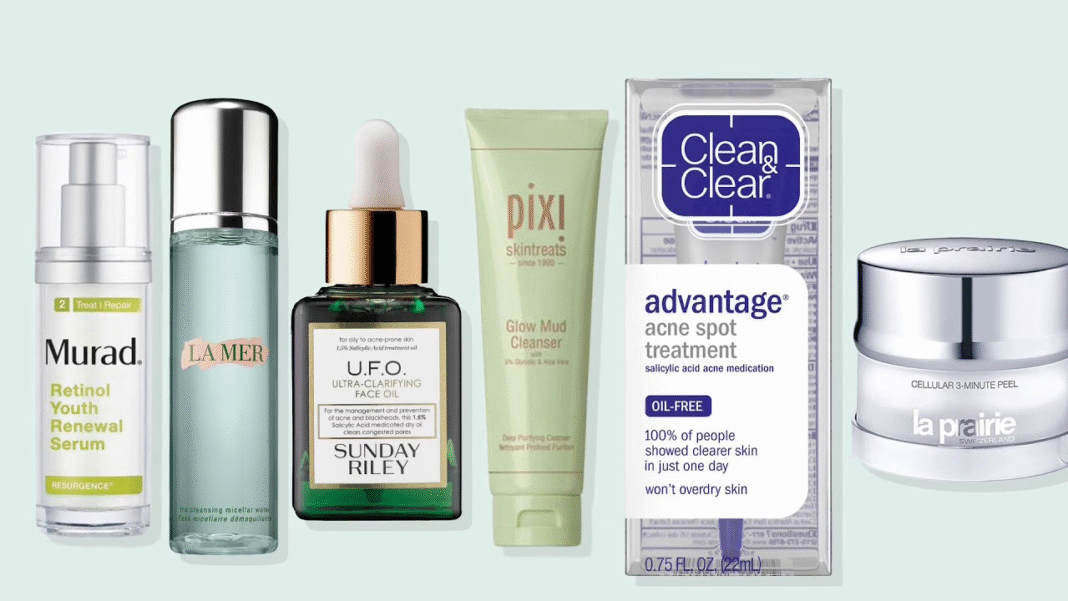If you have oily and acne-prone skin, you already know the struggle. Your face often feels greasy just a few hours after cleansing, makeup doesn’t last long, and breakouts show up uninvited at the worst times. The good news? With the right skincare routine, you can manage oil, minimize breakouts, and achieve healthier, clearer skin.
The secret isn’t using the harshest products possible, but rather building a gentle, consistent routine that balances oil production, fights acne-causing bacteria, and keeps your skin hydrated. Let’s explore the best skincare routine for oily and acne-prone skin, step by step.
1. Cleansing: The First Step to Oil Control
A good cleanser is the foundation of any skincare routine. For oily skin, choose a gentle foaming or gel-based cleanser that removes excess oil without stripping your skin.
- Look for ingredients like salicylic acid or benzoyl peroxide to unclog pores and prevent breakouts.
- Avoid harsh soaps or cleansers that leave your skin tight—this only makes your skin produce more oil.
- Wash twice a day: once in the morning and once at night. Overwashing can irritate and dry out your skin.
Pro Tip: If you wear makeup, double cleanse at night—use a lightweight oil or micellar water first, then follow with your regular cleanser.
2. Toning: Balance and Refresh
Toners help balance your skin’s pH and remove any leftover dirt or oil after cleansing. For oily, acne-prone skin:
- Choose alcohol-free toners with witch hazel, niacinamide, or green tea extract.
- These soothe the skin, tighten pores, and reduce excess oil.
- Avoid toners with heavy fragrance, which can irritate sensitive skin.
3. Exfoliation: Keep Pores Clear
Exfoliation removes dead skin cells that clog pores and cause breakouts. But don’t overdo it—2–3 times a week is enough.
Types of exfoliants:
- Chemical exfoliants: AHAs (like glycolic acid) and BHAs (like salicylic acid) gently dissolve buildup.
- Physical exfoliants: Scrubs with rough particles should be avoided, as they can irritate acne.
Best choice for oily skin: A salicylic acid-based exfoliant. It penetrates deep into pores, reducing oil and acne.
4. Serums: Targeted Treatment
Serums are powerful, lightweight formulas that target specific concerns like acne, scars, or oiliness. For oily, acne-prone skin, try:
- Niacinamide serum: Controls oil production, reduces redness, and improves skin texture.
- Vitamin C serum: Brightens skin and fades acne scars.
- Retinol (at night): Helps prevent clogged pores and improves cell turnover.
Start slow—introduce one serum at a time to avoid irritation.
5. Moisturizing: Yes, You Still Need It
Many people with oily skin skip moisturizer, thinking it will make their face shinier. The truth? Without hydration, your skin produces more oil to compensate.
- Choose oil-free, non-comedogenic moisturizers.
- Look for gel-based or water-based formulas.
- Ingredients like hyaluronic acid and aloe vera hydrate without clogging pores.
6. Sun Protection: Don’t Skip Sunscreen
Sunscreen is essential for everyone, especially if you use acne treatments like salicylic acid or retinol (which can make your skin more sensitive to the sun).
- Use an oil-free, matte-finish sunscreen with at least SPF 30.
- Look for formulas labeled “non-comedogenic” to avoid clogging pores.
- Apply daily, even indoors—UV rays can penetrate windows.
7. Night Routine: Repair and Restore
At night, your skin repairs itself, so focus on treatments:
- Cleanse your skin to remove oil, dirt, and makeup.
- Use a toner to balance.
- Apply a serum (like retinol or niacinamide).
- Moisturize to lock in hydration.
This helps control oil and prevent new breakouts while you sleep.
8. Lifestyle Habits That Support Clear Skin
Your skincare products matter, but so do your daily habits. For oily, acne-prone skin:
- Diet: Reduce sugary and greasy foods; add more fruits, veggies, and water.
- Stress management: Stress can trigger breakouts—try meditation, exercise, or deep breathing.
- Clean pillowcases and towels: Oil and bacteria can transfer from fabric to your skin.
- Hands off your face: Touching spreads dirt and bacteria.
Sample Morning Routine for Oily, Acne-Prone Skin
- Cleanser (gentle foaming)
- Toner (niacinamide or witch hazel)
- Lightweight serum (vitamin C)
- Oil-free moisturizer
- Sunscreen (SPF 30 or higher)
Sample Night Routine for Oily, Acne-Prone Skin
- Cleanser (double cleanse if wearing makeup)
- Toner
- Serum (retinol or niacinamide)
- Oil-free moisturizer
Conclusion
Managing oily and acne-prone skin doesn’t mean fighting your skin—it means working with it. The best skincare routine focuses on balancing oil, preventing breakouts, and keeping skin hydrated. With the right products and consistent habits, you can achieve healthier, clearer skin over time.
Remember, results don’t happen overnight. Stick to your routine, be patient, and your skin will thank you.
FAQs
1. Should I wash my face more often if I have oily skin?
No. Washing more than twice a day can strip your skin, leading to even more oil production. Stick to morning and evening cleansing.
2. Can oily skin skip moisturizer?
Absolutely not. Skipping moisturizer makes your skin produce more oil. Choose a lightweight, gel-based one instead.
3. Which ingredients should I look for in products?
Salicylic acid, niacinamide, benzoyl peroxide, retinol, and hyaluronic acid are all excellent for oily, acne-prone skin.
4. Will sunscreen make my skin more oily?
Not if you choose the right type. Look for oil-free, matte-finish sunscreens labeled “non-comedogenic.”
5. How long does it take to see results with a new skincare routine?
It usually takes 6–8 weeks of consistent use to see noticeable changes. Be patient and avoid switching products too often.




